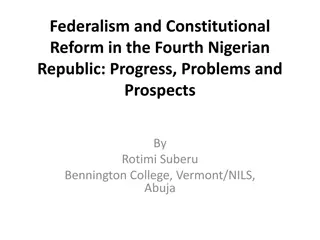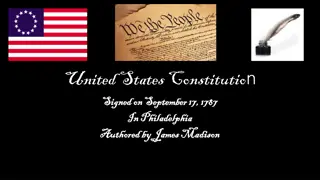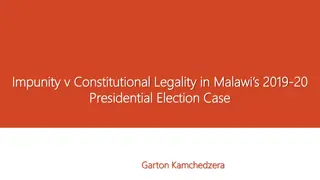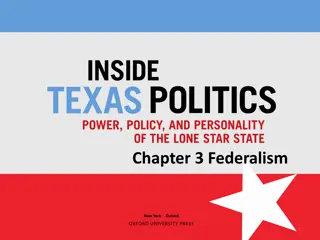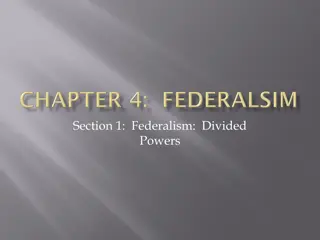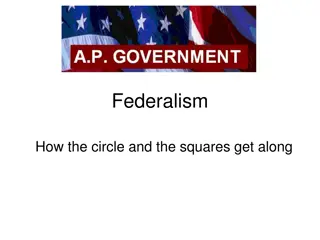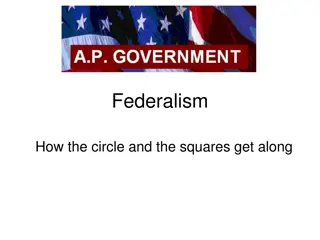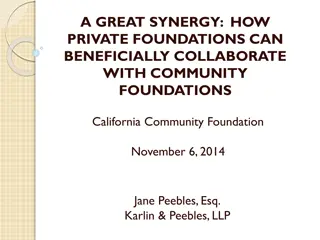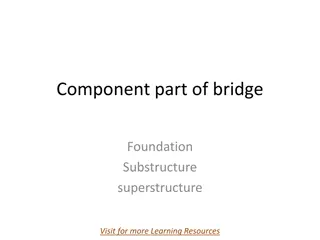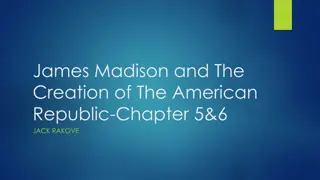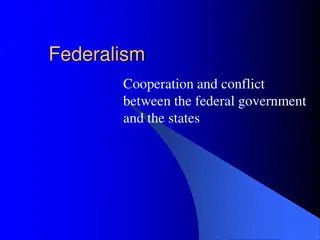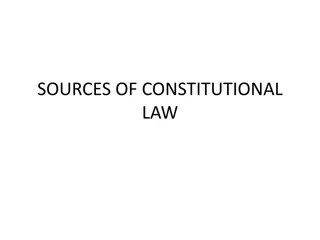Constitutional Foundations of Federalism and Key Stages
Federalism is a theory of political power division between national and state governments, highlighting decentralization. Explore the Constitutional foundations, different stages such as Dual Federalism, Cooperative Federalism, and New Federalism. Compare Federalism with the UK, and understand Enumerated Powers, Concurrent Powers, and Implied Powers in relation to the Constitution.
Download Presentation

Please find below an Image/Link to download the presentation.
The content on the website is provided AS IS for your information and personal use only. It may not be sold, licensed, or shared on other websites without obtaining consent from the author.If you encounter any issues during the download, it is possible that the publisher has removed the file from their server.
You are allowed to download the files provided on this website for personal or commercial use, subject to the condition that they are used lawfully. All files are the property of their respective owners.
The content on the website is provided AS IS for your information and personal use only. It may not be sold, licensed, or shared on other websites without obtaining consent from the author.
E N D
Presentation Transcript
Federalism Federalism A Level Government & Politics Students should be able to: Understand the Constitutional foundations of Federalism Identify the different stages of Federalism and their characteristics Compare and contrast Federalism with the UK
Federalism Federalism is: The theory by which political power is divided between a national and state government, each having their own clear jurisdiction One of the main themes of Federalism is decentralisation
Federalism and the Constitution Enumerated Powers Concurrent Powers Congress shall make all laws necessary and proper Implied Powers Elastic Clause All rights now mentioned here are reserved to the States 10th Amendment
An Ever Changing Concept Federalism is an ever changing concept, despite some of the Constitutional provisions for it. However, there are three key stages of federalism that have been defined Dual Federalism Cooperative Federalism New Federalism
Dual Federalism 1780-1920 Associated with a collection of unknown presidents Large Focus on States Rights Federal Government limited to Money, War and Peace Layer Cake Federalism Divisions in Political Power are Clear Cut
Cooperative Federalism 1930s 1960s Franklin Roosevelt, Harry Truman, John Kennedy, Lyndon Johnson Majority of the Presidents were Democrats New Departments Defence (1949), Health, Education, & Welfare (1953), Transportation (1966) Large Increase in Categorical Grants Grants allocated to states by Federal Government for specific projects Marble Cake Division in Political Power are less clear cut
New Federalism 1970s-2000 Nixon, Ford, Reagan, Bush and Clinton Majority of the Presidents were Republicans Shift back to State Power The Federal Government did not create the States; the States created the Federal Government Large Increase in Block Grants Grants allocated to states by Federal Government for non specific purposes or general areas
Why does Federalism Change? Federalism adapts to the country as it changes: This is down to several reasons Westward Expansion The US grows from 13 states to 50, so federalism changes Population Growth 4 Million people in 1790, to 275 Million in 2000 Industrialization As industry advances, Government must keep up with regulation Communication It becomes easier to communicate, meaning as the nation grows it shrinks. Events Events such as the Depression force the role of the Federal Government to increase
Why does Federalism Change? Foreign Policy Second World War and subsequent wars require a huge amount of central planning, so an increased role for the Federal government Supreme Court Rulings Any ruling on the constitution can change federalism, such as rulings on electoral law, civil rights or homosexuality Constitutional Amendments The passage of amendments can fundamentally alter the powers of the States or Federal Government
Evaluation of Federalism Pros Cons Permits Diversity Can hide economic and social inequalities Pluralistic Frustrates the national will, making solutions to problems harder Increased protection of individual rights Constant source of conflict between states and government States becomes policy labs e.g. Pollution permits in California Overly bureaucratic, therefore creating a costly system that is resistant to change Well suited to geographically large nation
Comparison with the UK The UK does not have a federal system of government. The UK is however a unitary state, that is highly centralised HOWEVER: With devolution to Scotland, Wales and Northern Ireland, and the passage of EVEL rules, is the UK becoming a more federal country?
Federalism Federalism A Level Government & Politics Students should be able to: Understand the Constitutional foundations of Federalism Identify the different stages of Federalism and their characteristics Compare and contrast Federalism with the UK


